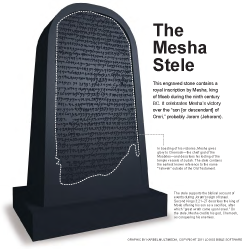16:1 Jehu the son of Hanani This is the only episode about Jehu in 1–2 Kings. In contrast, 1–2 Chronicles incorporates other traditions concerning him (2 Chr 16:7; 19:2–3; 20:34).
16:2–4 These verses refer to a prophecy that is otherwise unknown. This suggests that a prophet or prophecy may have supported Baasha’s rise to the throne, similar to Ahijah’s support of Jeroboam (1 Kings 11:29–39). |
16:2 the way of Jeroboam Indicates that practices initiated by Jeroboam—primarily the worship of golden calves and other idols—continued under Baasha (see 12:28–30; note on 12:28).
to provoke me The word qana means “provoke” or “incense,” resulting in anger (Gen 37:11; Num 5:14; Deut 32:21). Yahweh is provoked because Israel worshiped other gods (Exod 20:5).
16:3 like the house of Jeroboam This prophecy against Baasha resembles Ahijah’s prophecy against Jeroboam (1 Kings 14:10–11).
16:4 the birds of the heavens will eat These terms were likely the same as those presented in Jeroboam’s prophecy (see 14:11 and note).
16:5 The remainder of the acts of Baasha First Kings 15:16–21 records traditions concerning Baasha’s activities in Judah.
the events of the days of the kings of Israel See note on 14:19.
16:6 slept with his ancestors See note on 2:10.
16:8 the twenty-sixth year of Asa See note on 15:9.
16:9 Zimri This name later becomes an insult, indicating someone who murders his or her master (2 Kgs 9:31).
Tirzah Capital of the northern kingdom of Israel at this time.
16:11 all of the house of Baasha Like Baasha, Zimri eliminates political competition (Judg 9:1–6; 1 Kgs 15:29; 2 Kgs 10:1–11).
He left no males Unlike the versions presented to Jeroboam and Ahab (1 Kgs 14:10; 21:21), the prophecy in vv. 2–4 does not mention the death of every male.
16:13 their idols The Hebrew word used here, hevel, means “vapor,” “breath,” or “vanity” (compare vv. 26; Eccl 1:2). Hevel does not directly relate to idols, but it often appears in reference to them (see Jer 10:15; 16:19; 51:18). Israel’s “following after hevel” is the official reason for the fall of the northern kingdom (2 Kgs 17:15).
16:14 the events of the days of the kings of See note on 1 Kgs 14:19.
16:15 Zimri reigned Verses 8–12 records Zimri’s seizure of the throne.
16:19 his sin which he committed This accusation is part of the author’s formulaic record of Israel’s and Judah’s kings. The account of Zimri’s brief seven-day reign in 885 bc records the backlash of his coup. It is difficult to know what sins he committed within this week.
16:21–28 Omri |
Omride Dynasty | 885–841 bc |
Omri | 885–874 bc |
Ahab | 874–853 bc |
Ahaziah | 853–852 bc |
Joram/Jehoram | 852–841 bc |
16:21 Tibni Nothing more is known about this individual.
16:23 He reigned in Tirzah six years Omri captured Tirzah from Zimri (1 Kgs 16:18).
from Zimri (1 Kgs 16:18).
16:24 Samaria This region of the central highlands of Israel was deep in the heart of Israelite territory. The hill where Omri built this new capital city for the northern kingdom offered a commanding view of the surrounding area.
built this new capital city for the northern kingdom offered a commanding view of the surrounding area.
Samaria, The city of Samaria was rebuilt after the Assyrian destruction |
16:26 the way of Jeroboam The idolatry initiated by Jeroboam apparently continued during Omri’s reign (see 1 Kgs 12:28–30).
their idols See note on v. 13.
16:27 the events of the days of the kings of See note on 14:19.
16:28 slept with his ancestors See note on 2:10.
16:29–34 These six verses set the backdrop for the story of Elijah |
16:31 If it wasn’t enough that Ahab goes beyond Jeroboam’s sins (involving the golden calves and the high places; 12:28–33) and draws Israel into a political and religious relationship with the Sidonians, who worshiped Baal, the Canaanite storm god.
the Sidonians Refers to the people of Sidon, a major Canaanite and Phoenician city-state on the Mediterranean coast.
16:33 sacred pole Typically refers to a sacred pole used to worship the Canaanite goddess Asherah, but worship of the Canaanite god Baal and Asherah were often affiliated (Judg 6:25–30).
16:34 he laid its foundation Laying the foundation and setting up the gates mark the beginning and end of the construction process.
which he spoke by the hand of Joshua After the fall of Jericho, Joshua set a curse against any who would rebuild the city (Josh 6:26). This may explain the deaths of Hiel’s firstborn and youngest sons, who may or may not have been involved in the actual construction of Jericho.
Joshua set a curse against any who would rebuild the city (Josh 6:26). This may explain the deaths of Hiel’s firstborn and youngest sons, who may or may not have been involved in the actual construction of Jericho.

|
About Faithlife Study BibleFaithlife Study Bible (FSB) is your guide to the ancient world of the Old and New Testaments, with study notes and articles that draw from a wide range of academic research. FSB helps you learn how to think about interpretation methods and issues so that you can gain a deeper understanding of the text. |
| Copyright |
Copyright 2012 Logos Bible Software. |
| Support Info | fsb |
 Loading…
Loading…


 Samaria
Samaria 